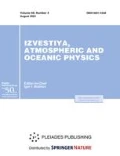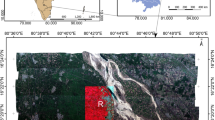Abstract
The NA-GS hyperspectral camera (Hyperspectrometer scientific instrument) produced by NPO Lepton (Zelenograd, Moscow) will be installed on the Russian segment of the International Space Station within a program for Earth remote sensing from space for experimentally testing the ground–space system for monitoring and forecasting the development of natural and manmade disasters. The practical application of this system is associated with performing tasks of thematic processing of hyperspectral images that should satisfy certain quality criteria. In this article, we propose a technique for assessing the operational capabilities of the NA-GS based on simulation and statistical modeling data. The concept of the proposed simulation and statistical model (SSM) includes modeling a test polygon of complex shape and simulating the observation of selected parts of the test polygon with a given accuracy using a hyperspectral sensor and taking into account cloud cover and the zenith angle of the Sun. The effect of external observation conditions on the quality of hyperspectral images is considered. Numerical experiments are conducted for the selected test areas. The analysis of the calculation results confirms the reliability of the proposed technique.





Similar content being viewed by others
REFERENCES
Aristov, S.A., Imitatsionnoye modelirovaniye ekonomicheskikh protsessov (Simulation Modeling of Economic Processes), Yekaterinburg: Ural’skii gos. ekon. univ., 2003.
Bakhvalov, Yu.O., Khatulev, V.A., Zavora, Yu.I., Mikheev, O.V., and Sudakov, V.M., New possibilities of simulation–statistical modeling for assessing the efficiency of ERS space systems, Issled. Zemli Kosmosa, 2015, no. 5, pp. 44–50.
Duffett-Smith, P., Practical Astronomy with your Calculator, Cambridge University Press, 1979; Moscow: Mir, 1982.
Kurenkov, V.I., Salmin, V.V., and Abramov, B.A., Osnovy ustroistva i modelirovaniya tselevogo funktsionirovaniya kosmicheskikh apparatov nablyudeniya (Fundamentals of Design and Simulation of the Targeted Operation of Observational Spacecraft), Samara: Samarsk. gos. aerokosm. univ., 2006.
Lychkina, N.N., Imitatsionnoye modelirovaniye ekonomicheskikh protsessov (Simulation Modeling of Economic Processes), Moscow: INFRA-M, 2012.
Ranson, K.J., Daughtry, C.S.T., and Bieh, L.L., Sun angle, view angle, and background effects on spectral response of simulated balsam fir canopies, Photogr. Eng. Remote Sens., 1986, vol. 52, no. 5, pp. 649–658.
Royer, A., Vincent, P., and Bonn, F., Evaluation and correction of viewing angle effects on satellite measurements of bidirectional reflectance, Photogr. Eng. Remote Sens., 1985, vol. 51, no. 12, pp. 1899–1914.
Zanter, K., Landsat 8 (L8) Data Users Handbook (Version 2.0), Department of the Interior, U. S. Geological Survey, 2016.
Funding
This work was supported by the Russian Science Foundation, project no. 16-11-00007, and the Russian Foundation for Basic Research, project no. 19-01-00215.
Author information
Authors and Affiliations
Corresponding author
Additional information
Translated by O. Pismenov
Rights and permissions
About this article
Cite this article
Zotov, S.A., Dmitriev, E.V., Shibanov, S.U. et al. Operational Capability Assessment for the NA-GS Hyperspectral Sensor Using Simulation and Statistical Modeling. Izv. Atmos. Ocean. Phys. 55, 1457–1464 (2019). https://doi.org/10.1134/S0001433819090597
Received:
Published:
Issue Date:
DOI: https://doi.org/10.1134/S0001433819090597




